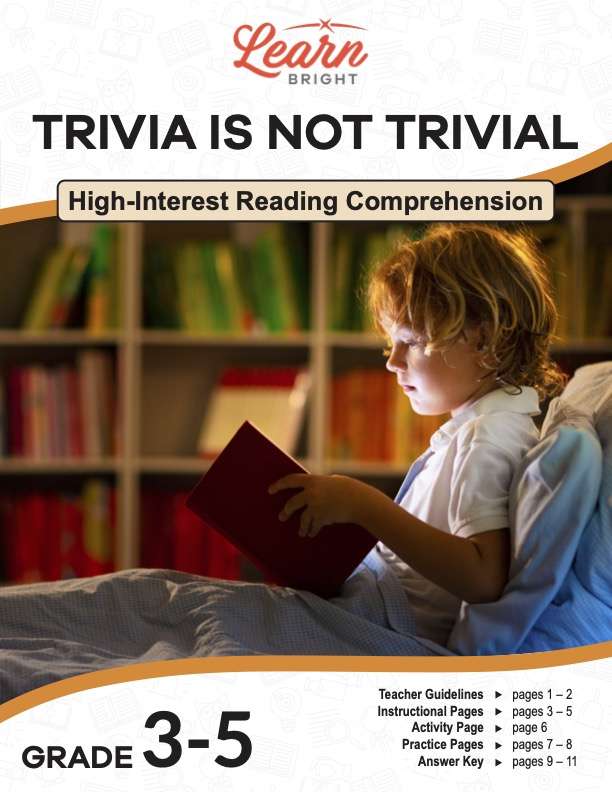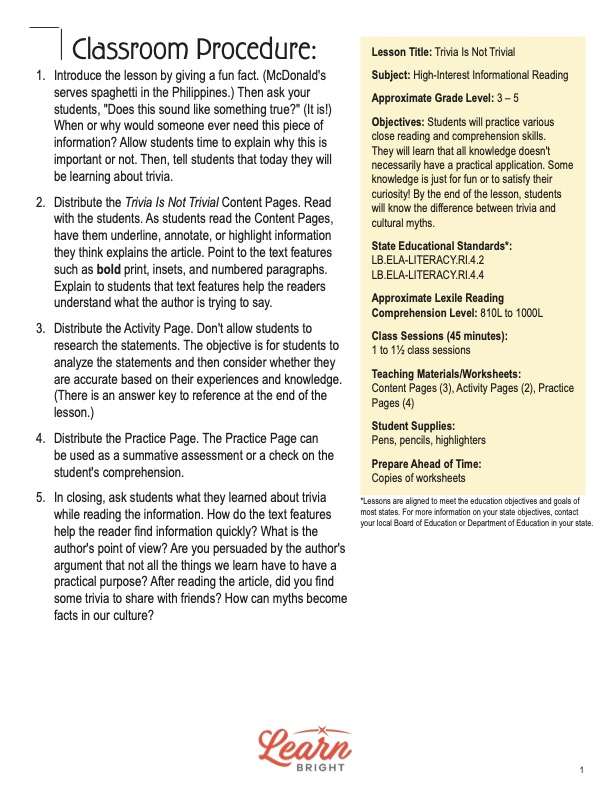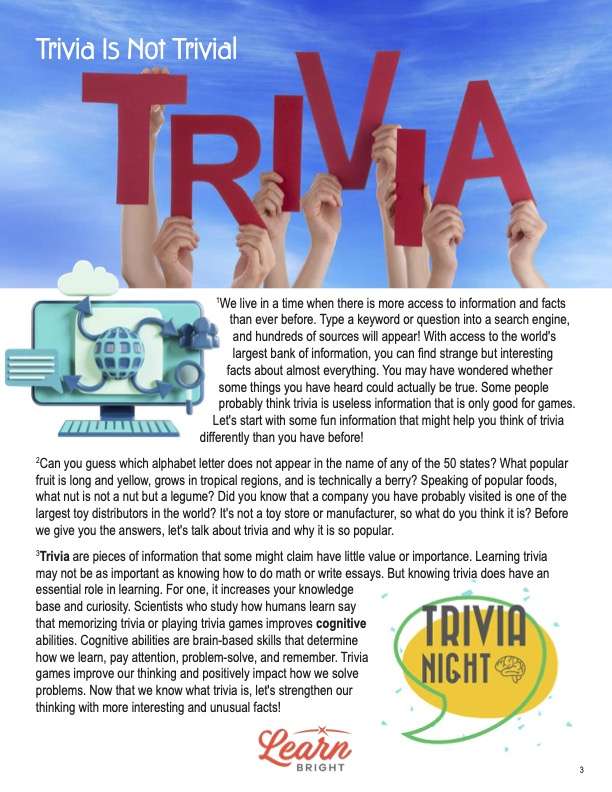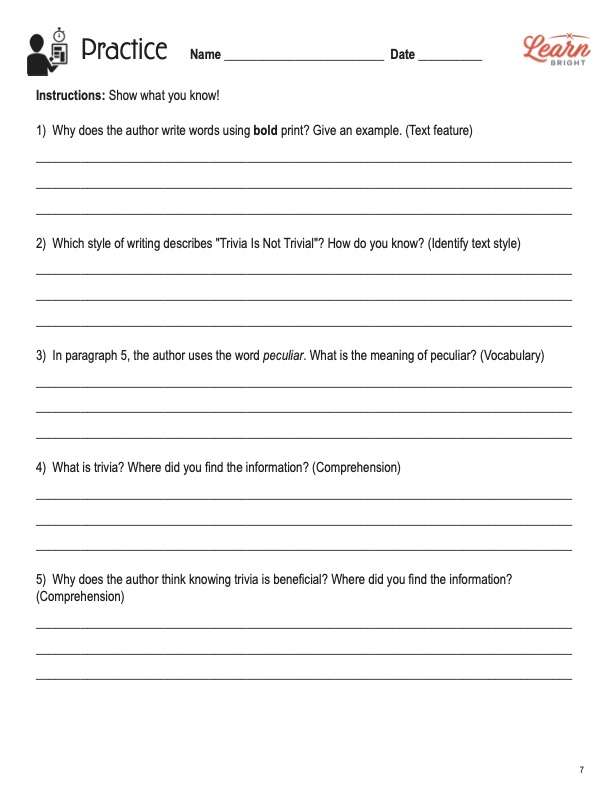Description
What our Trivia Is Not Trivial lesson plan includes
Lesson Objectives and Overview: Trivia Is Not Trivial is a high-interest reading comprehension lesson plan. As such, students will practice various close reading and comprehension skills. They will learn that not all knowledge necessarily has a practical application. Some knowledge is just for fun or to satisfy curiosity. By the end of the lesson, students will know the difference between trivia and cultural myths. This lesson is for students in 3rd grade, 4th grade, and 5th grade.
Classroom Procedure
Every lesson plan provides you with a classroom procedure page that outlines a step-by-step guide to follow. You do not have to follow the guide exactly. The guide helps you organize the lesson and details when to hand out worksheets. It also lists information in the yellow box that you might find useful. You will find the lesson objectives, state standards, and number of class sessions the lesson should take to complete in this area. In addition, it describes the supplies you will need as well as what and how you need to prepare beforehand.
Teacher Notes
The teacher notes page provides an extra paragraph of information to help guide the lesson and remind you what to focus on. It explains that you can teach this lesson in a whole-class setting or as an independent, small-group activity. The blank lines on this page are available for you to write out thoughts and ideas you have as you prepare the lesson.
TRIVIA IS NOT TRIVIAL LESSON PLAN CONTENT PAGES
Is Trivia Trivial?
The Trivia Is Not Trivial lesson plan contains three content pages. We live in a time when there is more access to information and facts than ever before. Type a keyword or question into a search engine, and hundreds of sources will appear! With access to the world’s largest bank of information, you can find strange but interesting facts about almost everything.
You may have wondered whether some things you have heard could actually be true. Some people probably think trivia is useless information that is only good for games. Let’s start with some fun information that might help you think of trivia differently than you have before!
Can you guess which alphabet letter does not appear in the name of any of the 50 states? What popular fruit is long and yellow, grows in tropical regions, and is technically a berry? Speaking of popular foods, what nut is not a nut but a legume? Did you know that a company you have probably visited is one of the largest toy distributors in the world? It’s not a toy store or manufacturer, so what do you think it is? Before we give you the answers, let’s talk about trivia and why it is so popular.
Why Trivia Can Be Useful
Trivia are pieces of information that some might claim have little value or importance. Learning trivia may not be as important as knowing how to do math or write essays. But knowing trivia does have an essential role in learning. For one, it increases your knowledge base and curiosity.
Scientists who study how humans learn say that memorizing trivia or playing trivia games improves cognitive abilities. Cognitive abilities are brain-based skills that determine how we learn, pay attention, problem-solve, and remember. Trivia games improve our thinking and positively impact how we solve problems. Now that we know what trivia is, let’s strengthen our thinking with more interesting and unusual facts!
Would it surprise you to learn that the first video game was invented in 1958 by a physicist? This game was created 25 years before the internet! Speaking of games, some of the most popular sports played today had early beginnings. One of the fastest-growing sports in America can be traced back to 1100 AD. Can you name the sport? Its early versions were played by Native American nations and included hundreds of men. Do you like board games? What is the oldest playable board game in the world?
Fun Trivia Facts
Maybe you aren’t interested in sports or board games. Perhaps you’re interested in more peculiar or unusual subjects. Here are some weird and interesting facts you can impress your friends or parents with. For one, sloths can hold their breath longer than dolphins—up to forty minutes—by slowing their heart rates. And if laid end to end, the human circulatory system would stretch to around 60,000 miles. That is nearly two and a half times around the earth’s equator!
Popsicles were accidentally invented by an 11-year-old boy named Frank Epperson in 1905. Originally, he called it the Epsicle, but Epperson would later change its name to Popsicle because that is what his kids called it. You can’t hum when you are holding your nose. German chocolate cake was created in Texas and is named after the inventor, Sam German, a baker who created a special baking chocolate in 1852. In 1957, Ms. George Clay used his chocolate formula and had her German chocolate cake recipe published by the Dallas Morning News.
The last letter added to the alphabet was J. The world’s largest waterfall is beneath the water’s surface at the Denmark Strait, separating Iceland and Greenland. Everyone knows humans have taste buds on their tongues, but that’s not the case for all animals. Lobsters have taste buds on their feet. Speaking of lobsters, their teeth are inside one of their stomachs. Yes, stomachs. Lobsters have three! Finally, here’s a gross fact. Dead skin cells are the main ingredient in dust. We shed up to 500 million skin cells a day! All those dead skin cells have to go somewhere.
Trivia Is Not Trivial!
By now, you may be thinking, what’s the point? Trivia can be interesting, but it’s certainly not helpful or practical. Here is a question for you: Does everything new you learn have to be useful or practical? A writer and poet named Berthold Auerbach said, “What is all our knowledge worth? We do not even know what the weather will be tomorrow.”
Not everything you learn has to have a specific purpose necessarily. Every object you come into contact with has a story behind it—often one you would never expect, like the fact that German chocolate cake was created in Texas! So, be curious and ask questions. You might learn a unique fact that totally blows your mind!
Answers to Trivia
The lesson then lists the answers to the questions from paragraphs 2 and 4. From paragraph 2: The letter in the alphabet that does not appear in the name of any of the fifty states is “Q.” The popular fruit that is long, yellow, grows in tropical regions, and is technically a berry is a banana. And the nut that is not a nut but a legume is the peanut. One of the largest toy distributors in the world is McDonald’s. (Every year, around 1.5 billion toys are included inside Happy Meals)
From paragraph 4: The first true video game was invented in 1958 by a physicist named William Higinbotham. It was called “Tennis for Two” and was the forerunner to a popular video game called “Pong.” The early versions of Lacrosse were played by Native American nations and included hundreds of men. “Royal Game of Ur” is the oldest playable board game in the world. It originated around 4,600 years ago in ancient Mesopotamia. Historians believe other board games existed before the “Royal Game of Ur,” but it is the only game that is intact and has written rules. The game is on exhibit in a British Museum.
TRIVIA IS NOT TRIVIAL LESSON PLAN WORKSHEETS
The Trivia Is Not Trivial lesson plan includes two worksheets: an activity worksheet and a practice worksheet. Each one will help students solidify their grasp of the material they learned throughout the lesson. You can refer to the classroom procedure guidelines to know when to hand out each worksheet.
TRIVIA OR MYTHS ACTIVITY WORKSHEET
For the activity, students will have to determine whether statements are true pieces of trivia or myths. There is a list of 20 statements for them to sort through. Students will cut out the statements and the trivia and myths categories and sort the statements under the correct category. There is an answer key for this activity for reference.
TRIVIA IS NOT TRIVIAL REVIEW PRACTICE WORKSHEET
The practice worksheet requires students to answer a series of 11 questions. These questions all relate to the content pages, so students will need to refer to them often for the answers. In addition, each question provides which reading tool the question corresponds to, such as text feature, vocabulary, or comprehension.
Worksheet Answer Keys
At the end of the lesson plan document are answer keys for the activity and practice worksheets. The correct answers are all in red to make it easier for you to compare them with students’ responses. If you choose to administer the lesson pages to your students via PDF, you will need to save a new file that omits these pages. Otherwise, you can simply print out the applicable pages and keep these as reference for yourself when grading assignments.









